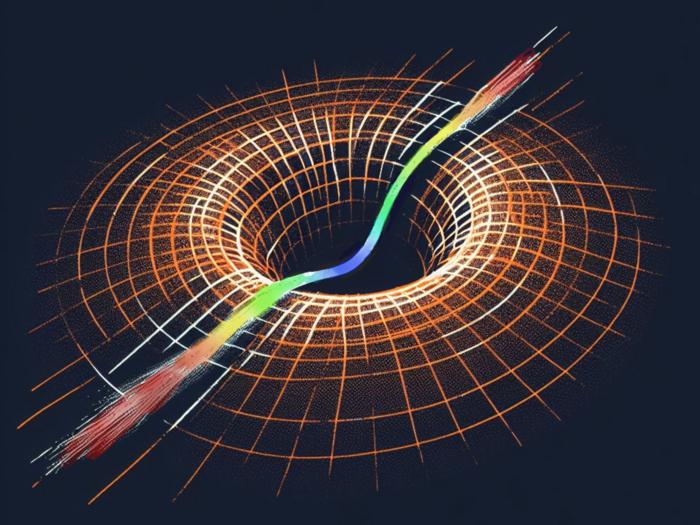Whenever light interacts with matter, light appears to slow down. This is not a new observation and standard wave mechanics can describe most of these daily phenomena.

Credit: Matias Koivurova, University of Eastern Finland
Whenever light interacts with matter, light appears to slow down. This is not a new observation and standard wave mechanics can describe most of these daily phenomena.
For example, when light is incident on an interface, the standard wave equation is satisfied on both sides. To analytically solve such a problem, one would first find what the wave looks like at either side of the interface, and then employ electromagnetic boundary conditions to link the two sides together. This is called a piecewise continuous solution.
However, at the boundary, the incident light must experience an acceleration. So far, this has not been accounted for.
“Basically, I found a very neat way to derive the standard wave equation in 1+1 dimensions. The only assumption I needed was that the speed of the wave is constant. Then I thought to myself: what if it’s not always constant? This turned out to be a really good question,” says Assistant Professor Matias Koivurova from the University of Eastern Finland.
By assuming that the speed of a wave can vary with time, the researchers were able to write down what they call an accelerating wave equation. While writing down the equation was simple, solving it was another matter.
“The solution didn’t seem to make any sense. Then it dawned on me that it behaves in ways that are reminiscent of relativistic effects,” Koivurova recounts.
Working together with the Theoretical Optics and Photonics group, led by Associate Professor Marco Ornigotti from Tampere University, the researchers finally made progress. To obtain solutions that behave as expected, they needed a constant reference speed – the vacuum speed of light. According to Koivurova, everything started to make sense after realising that. What followed was investigation of the surprisingly far-reaching consequences of the formalism.
No hope for a time machine?
In a breakthrough result, the researchers showed that in terms of accelerating waves, there is a well-defined direction of time; a so called ‘arrow of time.’ This is because the accelerating wave equation only allows solutions where time flows forward, but never backward.
“Usually, the direction of time comes from thermodynamics, where an increasing entropy shows which way time is moving,” Koivurova says.
However, if the flow of time were to reverse, then entropy would start to decrease until the system reached its lowest entropy state. Then entropy would be free to increase again.
This is the difference between ‘macroscopic’ and ‘microscopic’ arrows of time: while entropy defines the direction of time for large systems unambiguously, nothing fixes the direction of time for single particles.
“Yet, we expect single particles to behave as if they have a fixed direction of time!” Koivurova says.
Since the accelerating wave equation can be derived from geometrical considerations, it is general, accounting for all wave behavior in the world. This in turn means that the fixed direction of time is also a rather general property of nature.
Relativity triumphs over the controversy
Another property of the framework is that it can be used to analytically model waves that are continuous everywhere, even across interfaces. This in turn has some important implications for the conservation of energy and momentum.
“There is this very famous debate in physics, which is called the Abraham–Minkowski controversy. The controversy is that when light enters a medium, what happens to its momentum? Minkowski said that the momentum increases, while Abraham insisted that it decreases,” Ornigotti explains.
Notably, there is experimental evidence supporting both sides.
“What we have shown, is that from the point of view of the wave, nothing happens to its momentum. In other words, the momentum of the wave is conserved,” Koivurova continues.
What allows the conservation of momentum are relativistic effects. “We found that we can ascribe a ‘proper time’ to the wave, which is entirely analogous to the proper time in the general theory of relativity” Ornigotti says.
Since the wave experiences a time that is different from the laboratory time, the researchers found that accelerating waves also experience time dilation and length contraction. Koivurova notes that it is precisely length contraction that makes it seem like the momentum of the wave is not conserved inside a material medium.
Exotic applications
The new approach is equivalent to the standard formulation in most problems, but it has an important extension: time-varying materials. Inside time-varying media light will experience sudden and uniform changes in the material properties. The waves inside such materials are not solutions to the standard wave equation.
This is where the accelerating wave equation comes into the picture. It allows the researchers to analytically model situations which were only numerically accessible before.
Such situations include an exotic hypothetical material called disordered photonic time crystal. Recent theoretical investigations have shown that a wave propagating inside the said material will slow down exponentially, while also increasing exponentially in energy.
“Our formalism shows that the observed change in the energy of the pulse is due to a curved space-time the pulse experiences. In such cases, energy conservation is locally violated,” Ornigotti says.
The research has wide-reaching implications, from everyday optical effects to laboratory tests of the general theory of relativity, while giving an idea of why time has a preferred direction. The study titled Time-varying media, relativity, and the arrow of time was published on 19 October 2023 in the journal Optica.
Journal
Optica
DOI
10.1364/OPTICA.494630
Article Title
Time-varying media, relativity, and the arrow of time
Article Publication Date
19-Oct-2023




